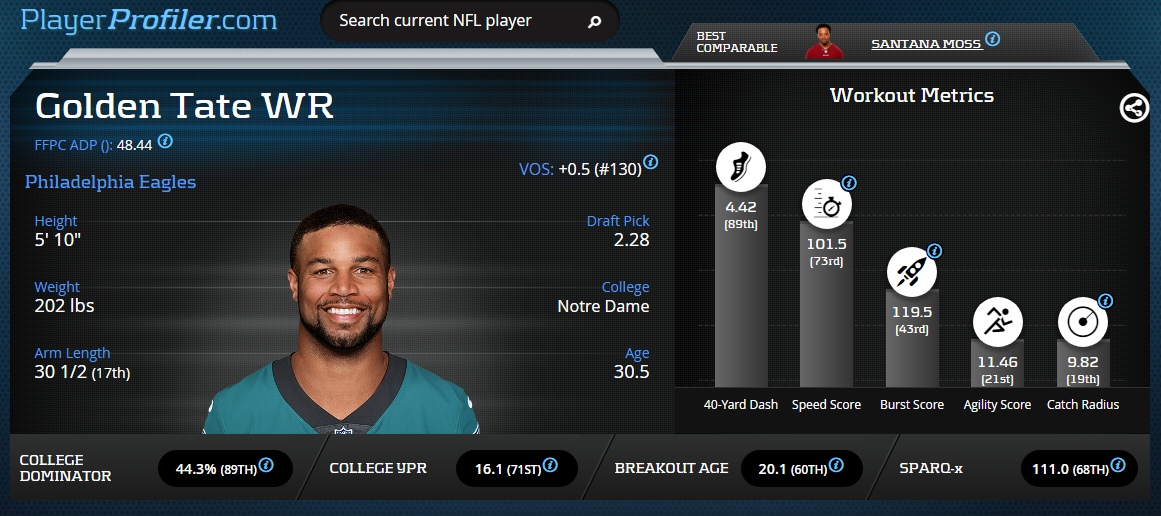Each season in the NFL a wide receiver explodes out of no where and enters the hearts of fantasy enthusiasts. Unfortunately, many of these receivers who pop up for big seasons regress in future years. From Terrelle Pryor to Kenny Britt to Allen Hurns, each of whom recorded a 1,000 yard season in the last few seasons, these receivers rarely continue into the upper echelons at the position. Looking at PlayerProfiler’s advanced stats and metrics a number of receivers immediately stand out as potential 2019 regression candidates.
Jarvis Landry, Cleveland Browns
Signed to a $75 million dollar contract last off-season, Jarvis Landry struggled in his first season with the Cleveland Browns, turning 148 targets into 81 catches for 976 receiving yards. Perhaps 2018 represented an anomaly for Landry? However, looking back to 2017, the ex-Dolphin performed even worse, recording 987 receiving yards on 112 catches and 161 targets.
With disappointing counting stats beginning to add up, Landry equally disappoints when looking at advanced efficiency metrics. Among 40 receivers with at least 90 targets in 2018, Landry ranked dead last in Target Premium (-21.9-percent) and third-worst in Production Premium (-15.9), which measure Landry’s productivity against his own teammates and his peers across the league. He also posted a dismal 78.5 QB Rating When Targeted (No.88), adding little to the offense himself.
https://www.youtube.com/watch?v=fXBL719dYKY
Looking at Landry’s collegiate profile, he entered the league with a 79.9 SPARQ-x Score (1st-percentile). Within this SPARQ-x Score, his 103.5 Burst Score and 12.15 Agility Score ranked in the 0-percentile. An un-athletic, unproductive receiver at the NFL level, Landry’s time atop the Cleveland Browns’ depth chart may come to a close with the NFL Draft approaching.
Allen Robinson, Chicago Bears
Since amassing 1,400 receiving yards in 2015, Allen Robinson failed to eclipse 883 receiving yards in any single season. 2018 proved much of the same for Robinson, with 754 yards on 55 receptions. In Robinson’s defense, he only played 13 games somewhat depressing his box score stats. However, the efficiency metrics tell a different story, showing the same inefficiency that has plagued Robinson throughout most of his career.
https://www.youtube.com/watch?v=ETCMKYlW0bU
Much like Landry, Robinson too ranked within the bottom ten of qualified receivers in Target Premium (-8.4-percent) and Production Premium (-5.1). Robinson’s 85.1 QB Rating When Targeted also reflects his 2018 struggles. In comparison, Taylor Gabriel (91.1) and Anthony Miller (117.5) bested his QB Rating When Targeted. Digging a little deeper, this makes sense with Robinson ranking dead last among 40 qualifiers in Target Separation (0.97). An overall inefficient receiver with difficulty separating, Robinson could find himself with a diminished role if Miller and other teammates ascend.
Golden Tate, Philadelphia Eagles (Free Agent)
Previously one of the most productive receivers in fantasy football, Golden Tate regressed severely in 2018. Despite seeing 113 targets and recording 74 receptions, Tate only managed 795 receiving yards and fell below a 50-percent snap share in five of his games. Heading into free agency and his age-31 season, the optimism around Tate must be tempered.
Like those above, Tate fell short in some key PlayerProfiler metrics. His -10.4 Production Premium (No.68) and his -13.6-percent Target Premium (No.87) both ranked outside the top 60 at the wide receiver position.
More importantly, Tate struggled to squeeze the football despite a minuscule 6.7 average target distance (No.104). While he saw a 83.2-percent Catchable Target Rate (No.21) and a 3.0 Target Accuracy (No.15), Tate only posted a 78.7-percent True Catch Rate (No.78).
https://www.youtube.com/watch?v=TGzh6G_WK5U
While a team will likely overpay for Tate’s services in a wide receiver-hungry league, Tate’s efficiency remains a major concern. Transitioning teams and declining in productivity, Tate looks like a solid avoid candidate for 2019.
Nelson Agholor, Philadelphia Eagles
Playing as Tate’s teammate for part of 2018, Nelson Agholor posted his second season above 700 receiving yards after a disappointing start to his career. However, similar to Tate, Agholor posted poor efficiency throughout 2018, opening the door for the Eagles to target a wide out in free agency or the NFL Draft.
A plus-athlete coming out of USC, Agholor posted a 102.3 Speed Score (75th-percentile) and a 124.6 Burst Score (69th-percentile). However, through four years in the NFL, Agholor has been unable to put his athleticism all together on the field. Much like Tate, Agholor performed only marginally better from an efficiency standpoint, with a -4.8 Production Premium (No.58) and a -6.4-percent Target Premium (No.63). Agholor also struggled to gain separation throughout the season, posting a 1.14 Target Separation (No. 91).
https://www.youtube.com/watch?v=thP5HOTVBIE
With the Eagles possessing two of the most inefficient receivers in football last season, targeting another pass catcher in the NFL Draft should remain one of the team’s top priorities.
Larry Fitzgerald, Arizona Cardinals
Heading into his age-36 season, Larry Fitzgerald recently signed a 1-year $11 million dollar contract to stay an Arizona Cardinal. This security has caused his early Bestball ADP to soar inside the top 100. However, in addition to the age and poor supporting cast, Fitzgerald has shown major signs of slowing down in advanced analytics.
Looking at efficiency metrics, Fitzgerald remained a productive target in the context of the Cardinals’ offense with a +27.5-percent Target Premium (No.14). However, comparing his efficiency to receivers across the league, Fitzgerald struggled mightily, recording a -4.4 Production Premium (No.55). This speaks to the horrid situation the Cardinals provided for their rookie QB, Josh Rosen.
https://www.youtube.com/watch?v=7uOHLoF2DvU
Making matters even more difficult for their rookie signal caller, Fitzgerald recorded the second-worst Target Separation (1.03) among 40 receivers with 90 targets, despite finishing as the most efficient target on the Cardinals. Forced into anticipatory throws as a rookie, Fitzgerald’s low 91.1 QB Rating When Targeted (No.61) should come as no surprise.
Heading into 2019, projecting Fitzgerald for another 112 targets looks like a stretch. It remains more likely that he plays a complimentary role as a mentor, while Christian Kirk and potentially another free agent/NFL Draft addition learn under his tutelage.









